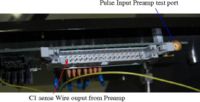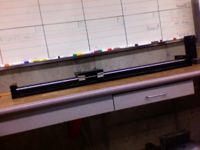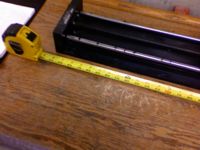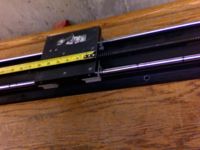Difference between revisions of "Mini-prototype"
| Line 79: | Line 79: | ||
|Distance | |Distance | ||
|colspan= "2" | |colspan= "2" | ||
| − | + | Feedthrough Efficiency | |
|- | |- | ||
| || plastic || metal | | || plastic || metal | ||
Revision as of 18:21, 19 September 2007
Drift Chamber prototypes were constructed to evaluate drift chamber designs for CLAS12.
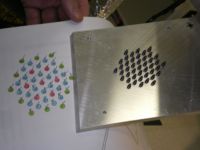
Mini-prototype Performance Measurements
Description of General Operation
Chamber Ionization Gas
Our initial plan will be to use (75/25) flowing though the chamber at a flow rate high enough to exchange the volume once a day.
high Voltage supply
A CAEN 4 channel high voltage supply (N470) will be used to supply HV to the drift chambers. The supply is capable of monitoring currents at the microAmp(A) level and voltages at the Volt (V) level.
Signal Processing

The 7 sense wire signals from the mini-prototype drift chambers will be processed through several
NIM based modules.
One can expect to amplify the sense wire output from a factor of 10 to 30 times. We will use our
Ortec amplifier to amplify the
sense wire output by a factor of 10.
A descriminator from Lecroy with a threshold range from 30 mV up to 1.5 Volts will be used to create a stop pulse for TDCs
that are started by scintillators which detect either an electron, during tests at the IAC, or cosmic rays, during tests at the LDS (see below). Hall B has loaned the ISU group a
TDC module for the drift chamber studies. Pulse height studies may also be done using an ADC. The DAQ system to manage the signal processing electronics is described below.
DAQ System
The DAQ system is described here
Cosmic tests
Apparatus
Place chamber between two plastic scintillator paddles to check signals. We will use the large area 7 cm by 50 cm paddles with the Russian PMTs operating at 1300 V and threshold > 150 mV to select energetic cosmic rays. We will arrange the paddles so that they are perpendicular to one another. From above, the paddles will have 7 cm by 7 cm overlap. This will allow for testing the chamber along its length.
scope pulses
We will insert oscilloscope pictures of the Drift Chamber output signals we observe.
Planned tests
We will use the scintillator paddles to detect cosmic rays and perform the following tests:
1. Efficiency along length of chamber with overlapping array of scint. paddles optimized for normal incidence.
2. Efficiency as a function of discriminator threshold, i.e. what is the required energy of the cosmic ray.
3. Efficiency as a function of angle. Count rates will decrease so we will have to determine the best overlapping configuration of the paddles.
The above tests will give us a baseline for the drift chamber and are not designed to evaluate the efficiency as a function of distance from the endplate due to the large angular divergence of the incident cosmic rays and the limited counting statistics. We will use a finely collimated secondary electron beam at the IAC in order to make precision measurements of the efficiency as a function the ionization event distance from the endplate.
Electron test facility
IAC 25 MeV electron accelerator
The Idaho Accelerator Center (IAC) operates a 25 MeV Linac capable of delivering instantaneous electron currents of 80 mA/pulse. Pulse widths range from 80 ns to 2 s and repetition rates from single shot to 1 kHz. Drift Chamber testing will use this accelerator to create a secondary electron beam as described below.
secondary electron beam setup
We will need to bring the electron beam from Accelerator lab #1 to the experimental testing cell labeled as "target room" .
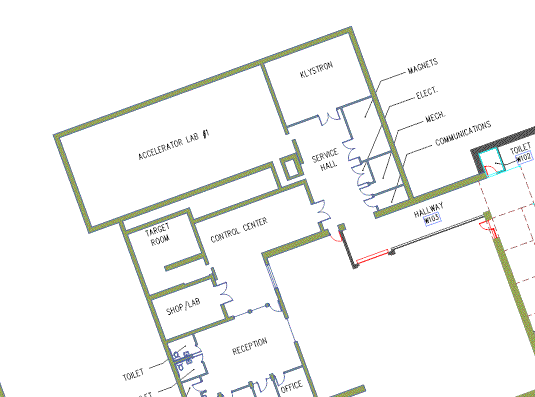 Floor Plan of IAC.
Floor Plan of IAC.
An evacuated beam pipe from the current exit window of the LINAC to the collimator entrance at the wall will be built to accomplish this. Magnetic elements are already in place to stear electrons into the "target room". The pipe will have aluminum windows at either end to allow for passage of the electron beam. Phil will be responsible for the design and safety concerns of implementing the pipe. The wall is 6' thick, which is 4' of packed earth sandwiched between 1' of concrete on either side. Upon reaching the wall the electron beam will travel through the hole defined by the collimator aperture. The electron beam will have to travel through a distance of 8' of air as it goes into the experimental test cell. The radiation length of air at STP is over 300 m, so this ought not be a problem. We can place an insert into the collimator on the test cell side to define the electron beam if need be.
We will use Dan's idea of elastic scattering. See: http://www.physics.isu.edu/~cole/IAC/DC_prototype/Detector-Test.pdf
The idea: the beam is incident upon a pencil lead target and the electrons will elastically scatter off the carbon atoms. The prototype will be positioned perpendicular to the incident electron beam so that only the elastically scattered electrons will pass through the chamber. We will place 5 mm by 5 mm scintillators on either side of the chamber. This scintillator arrangement allows for triggering and defining the beam. The paddles will be fixed and the prototype will be on a moveable platform that will be controlled by a stepper motor. This will allow us to measure the sense wire efficiency along the length of the wire and, in particular, the efficiency in close proximity to the feedthroughs.
Description of how beam size will be measured or why it isn't needed.
stepper device
I think the device below can be used to move the minichamber across the backscattered electron beam. The device is over 3 feet in length and has a platform with is 6" x 6". We should configure the platform so it can hold both chambers "back-to-back" in order to test both chambers at the same time. The first chamber has four 3/8" bolts on the bottom for mounting but the 2nd one has yet to have anything.
Drift Chamber efficiency measurements
Efficiency -vs- Distance
The secondary electron beam will be moved towards the drift chamber endplate while the efficiency is measured. The results of our tests will be placed below.
| Distance | colspan= "2"
Feedthrough Efficiency | |
| plastic | metal | |
| 2 | ||
| 4 | ||
| 6 | ||
| 8 | ||
| 10 | ||
| 12 | ||
| 14 |
Metal feedthrough
Radiation Tests on Gas
Place chamber in main hall and direct high current electrons through the prototype.
1. Do not flush gas. How long does it take before the efficiency detiorates due to radiation damage of the gas.
2. Flush gas at variable rates to determine what the mininum flush rate is to ascertain proper stable efficiency.
HV connections and Readout
The High Voltage lines are shown below along with labels for the three voltages. I will try to install SHV connectors as well as a plastic safety shield to keep a student's finger away from the HV.
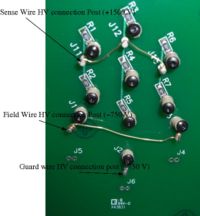
Preamp power connector inputs
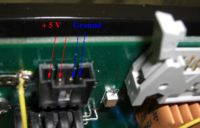
Output connector. Preamp output signals are differential.
